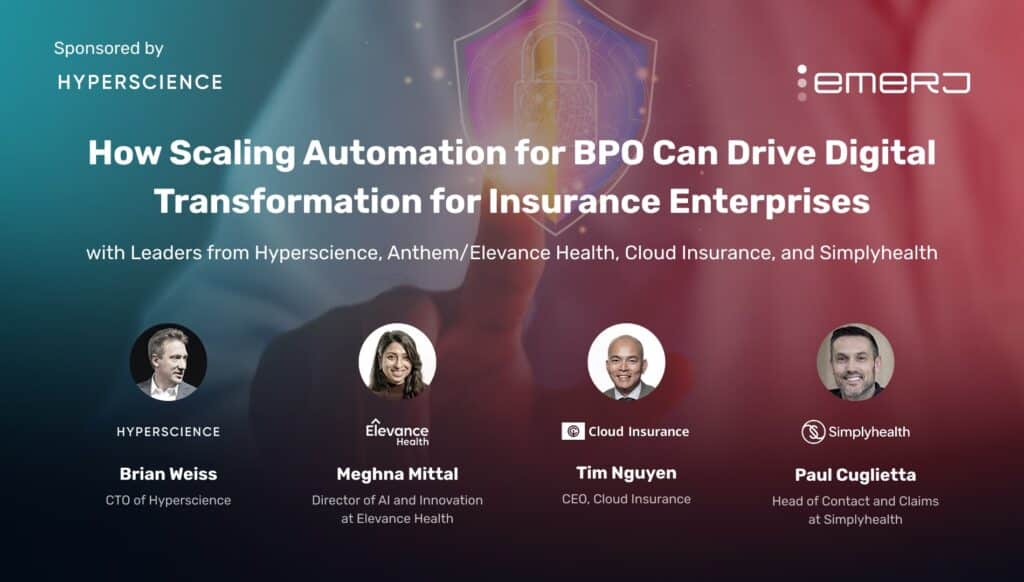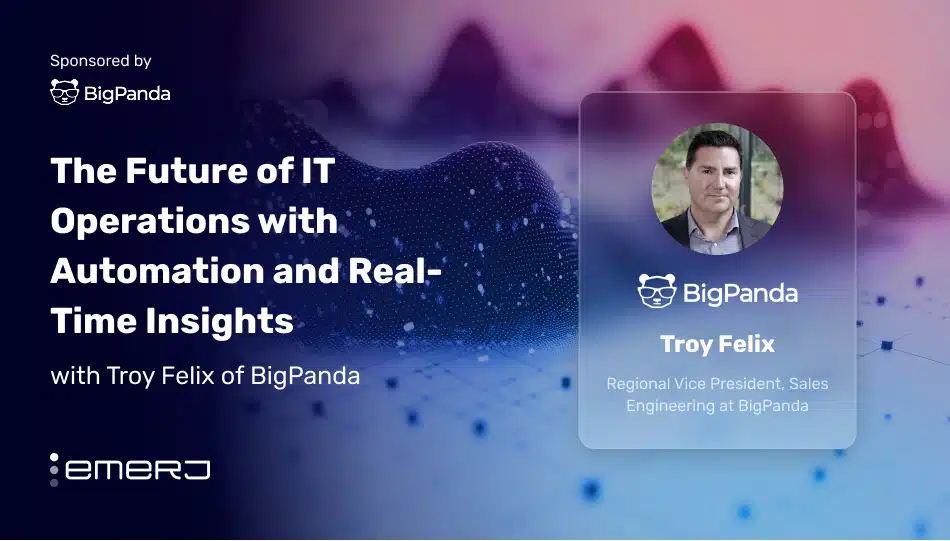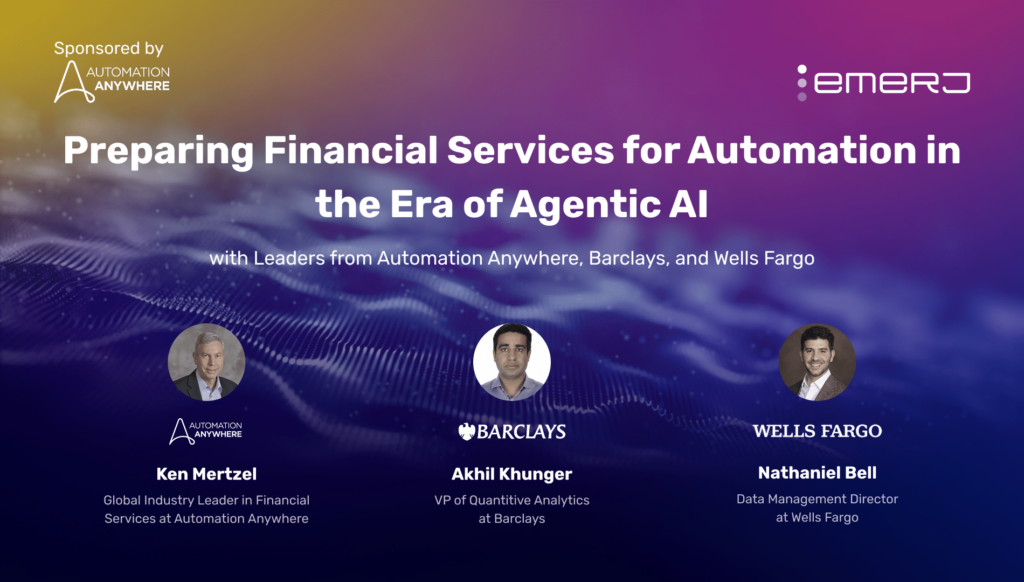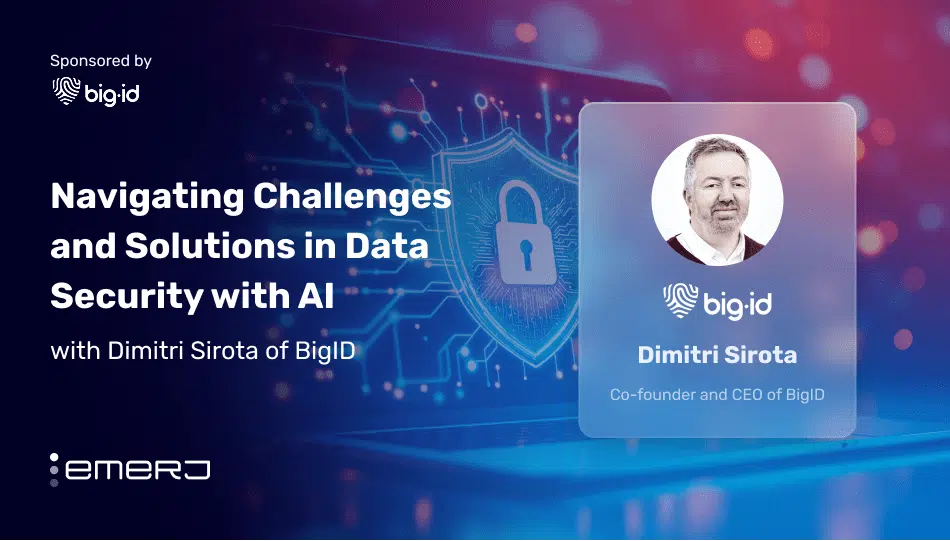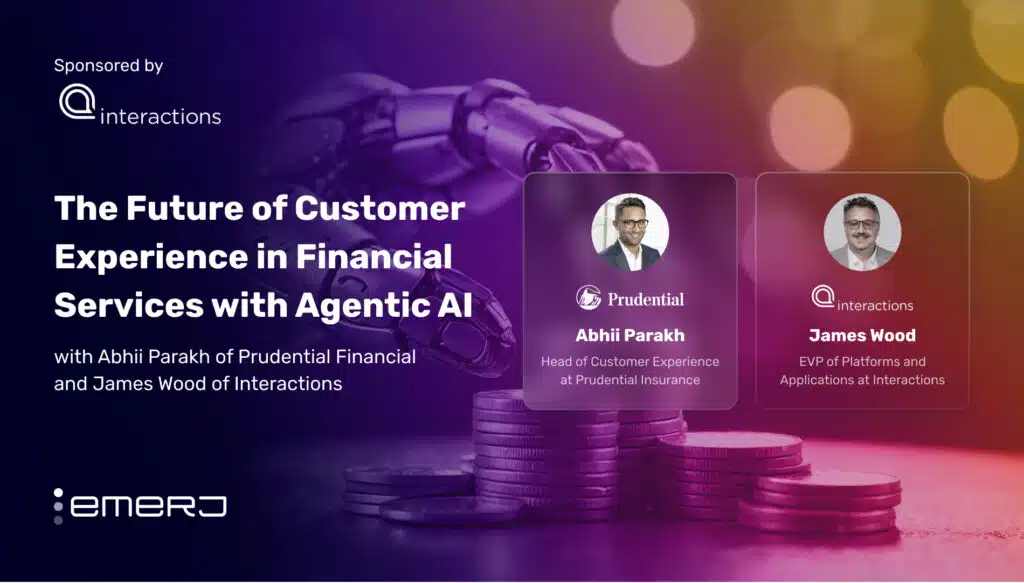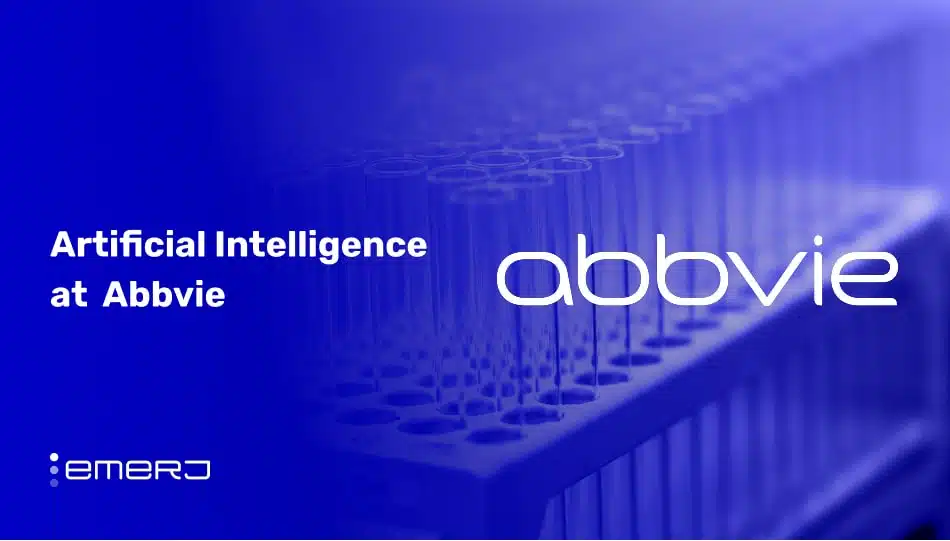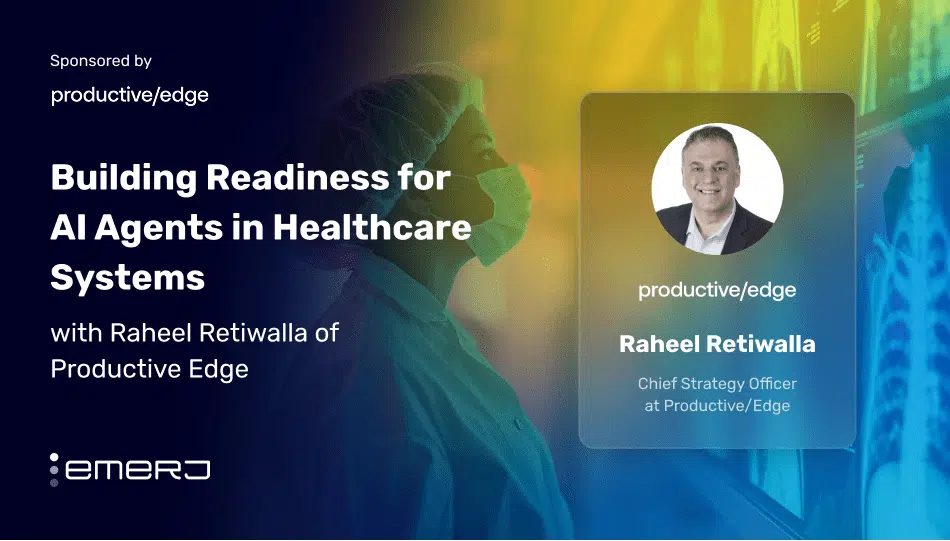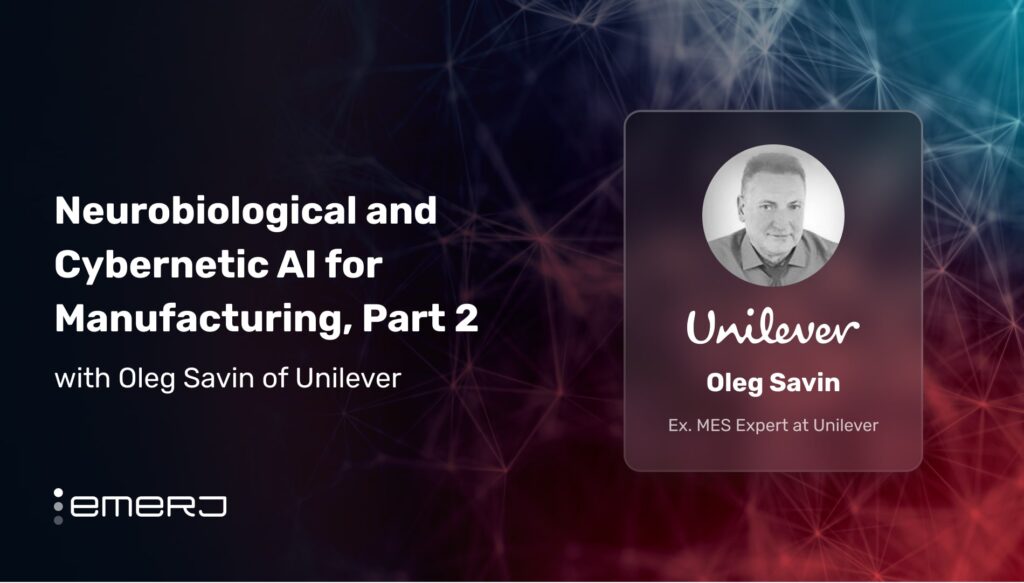This interview analysis is sponsored by Hyperscience and was written, edited, and published in alignment with our Emerj-sponsored content guidelines. Learn more about our thought leadership and content creation services on our Emerj Media Services page.
Business Process Outsourcing (BPO) has long been a strategic tool for enterprises looking to streamline operations and reduce costs. However, as legacy industries like financial services and insurance undergo digital transformation, automation technologies — mainly Robotic Process Automation (RPA) and machine learning are redefining the value proposition of BPO.
Automation-at-scale – especially at hyper-scale – is no longer just a cost-saving mechanism for the growing enterprise; it is becoming a core driver of strategic insights and operational agility. According to a report by McKinsey & Company, organizations that automate business processes see efficiency gains of up to 30–60%, particularly in high-volume, rules-based workflows like claims processing, loan underwriting, and customer support.
A paper from the International Journal for Multidisciplinary Research titled “The Basics of Robotic Process Automation in Insurance Claims” highlights the transformative impact of RPA on insurance claims processing. Key findings include a 90% reduction in processing time, cutting it down from 72 hours to under 5 minutes, and 40-70% cost reductions in claims operations. The paper also cites that insurance carriers adopting RPA report a 65% decrease in customer service costs, automation of 92% of routine customer interactions, and a 30-point improvement in Net Promoter Scores.
Emerj Senior Editor Matthew DeMello recently spoke with a broad range of insurance and regulated industry experts on Emerj’s ‘AI in Business’ podcast, including Brian Weiss, CTO at Hyperscience, Meghna Mittal, Director of AI and Innovation at Elevance Health, Tim Nguyen, CEO of Cloud Insurance and Paul Cuglietta, Head of Contact and Claims at Simplyhealth.
Together, the conversations featured in their podcast series laid bare the role of automation and AI in transforming industries, emphasizing the need for strategic implementation, effective integration, and continuous skill development to maximize ROI and enhance operational efficiency.
Elevance Health (formerly Anthem, Inc.) is an American for-profit health insurance provider offering medical, pharmaceutical, dental, behavioral health, long-term care, and disability plans.
Simplyhealth is a UK-based healthcare company that provides affordable health and dental insurance plans, offering members cash back for various medical services and access to virtual healthcare solutions.
Cloud Insurance is an insurtech SaaS solution that helps insurance companies, agents, and brokers automate their insurance lifecycle, offering a flexible platform that can decrease time-to-market and increase revenue.
This article examines three critical insights for driving automation in back office tasks from their conversations:
- Leveraging AI to transform back office operations: Integrating AI to automate repetitive tasks, improving efficiency and reducing reliance on human labor while ensuring accuracy and cost-effectiveness.
- Orchestrating multiple technologies for success: Leveraging a combination of tools, including GenAI and traditional machine learning, to solve the right problem with the right technology, avoiding the trap of applying one tool to all situations.
- Automating claims processing with AI: Implementing AI to match customer data with coverage, applying fraud detection, and automatically processing claims to improve efficiency and reduce costs.
- Running a multi-skilled reward program to boost adaptation to automation: By implementing a multi-skilled reward program, companies can incentivize employees to learn new skills and adapt to automation, enhancing both operational efficiency and employee value.
Leveraging AI to Transform Back Office Operation
Episode: Hyperautomation and the Future of Business Process Outsourcing – with Brian Weiss of Hyperscience
Guest: Brian Weiss, Chief Technology Officer, Hyperscience
Expertise: Hyperautomation, AI, Data Analytics
Brief Recognition: Brian Weiss is the Chief Technology Officer at Hyperscience. He has previously held roles at leading companies such as OpenText, HP, and HPE. He holds a degree from the University of California, Berkeley.
Brian highlights how the current excitement around AI is shifting innovation budgets toward back-office functions, which were traditionally seen as mundane and handled by people through Business Process Outsourcing (BPO). Tasks like reading and interpreting documents—once outsourced because machines couldn’t handle them, are now being tackled with AI, explicitly using deep learning models that improve over time through feedback.
Brian explains that the AI industry is moving from hype to a more realistic, mature phase. Companies realize that AI can drive dramatic automation improvements, especially with messy human data, but it needs to be deployed safely and transparently. Hyperscience, for example, has been refining this for years, allowing customers to build their own secure, proprietary models tailored to specific tasks—especially in sensitive sectors like government, finance, and insurance.
Instead of relying on broad, expensive models, businesses are creating narrow, efficient ones that deliver high accuracy for specific workflows, all while maintaining control over their data. This balance between automation, cost-efficiency, and data security is driving the current AI adoption trend, with human oversight still essential for ensuring accuracy.
He outlines a stepwise AI maturity curve for organizations:
- Transition from rules-based to model-based systems: This shift helps companies manage accuracy rates and move beyond outdated methods.
- Focus on accuracy: Implement an “accuracy harness” to track performance with just-in-time human intervention and assess the cost—time, resources, and human effort—of achieving accuracy.
- Minimize human involvement: Aim for human-level accuracy with minimal manual input and leverage clean business data for broader AI use cases like digital assistants.
- Rethink performance metrics: Traditional metrics like straight-through processing are less useful. Focus on correctness, cost-efficiency, and improving the AI system itself.
- Back office as an AI innovation hub: The back office is becoming central to AI advancements, helping drive efficiency and smarter systems across the business.
Emphasizing the importance of these five steps, Brian then underscores the value chain of an entire verification process many enterprises already adopt for document processing. No matter what the number of documents involved, Brian emphasizes that value boils down to a simple question:
“The question is not ‘Did a certain number of documents come out of the system?’ The question is, what was their correctness? What did you have to do in order to get them to 100% correct? How many people did you leverage? How much money and time and people did you spend on that?”
– Brian Weiss, Chief Technology Officer at Hyperscience
Orchestrating Multiple Technologies for Success
Episode: Overcoming Regulatory Hurdles in Healthcare Innovation – with Meghna Mittal of Anthem
Guest: Meghna Mittal, Director of AI and Innovation, Elevance Health
Expertise: Data Science, Leadership, Artificial Intelligence
Brief Recognition: Meghna Mittal is the Director of AI and Innovation at Elevance Health, where she leads the development of AI capabilities across the organization, helping the AI teams deliver scalable enterprise solutions. She holds a Ph.D. in Mathematics from the University of Houston.
Meghna stresses that IT automation is more critical than ever with AI’s rise. While GenAI is powerful, it’s just one tool—success lies in orchestrating multiple technologies. She warns against applying GenAI to everything.
“GenAI is just another tool in our toolkit, alongside traditional automation and machine learning models. The challenge is that when people have a new tool like a hammer, they see every problem as a nail. That’s what’s happening with GenAI. Many assume it can solve everything, but that’s not the case. The key is orchestrating all available tools effectively to address the right problem with the right solution.”
– Meghna Mittal, Director of AI and Innovation at Anthem Healthcare
She then shifts to the topic of interoperability, discussing how automation and cloud-based solutions are helping integrate legacy systems more effectively. These advancements are enabling organizations, including hers, to create unified data systems, which are crucial for improving patient records and delivering personalized care.
She also highlights that many healthcare organizations are moving toward cloud-based integrations to build a more seamless and connected experience for their members. This effort is foundational to providing better communication and personalized healthcare services in the long run.
Meghna ends by sharing three key principles she finds valuable when trying to win buy-in for automation use cases:
- Bringing People Along: Cross-team influence in the adoption process is crucial. No matter how great a solution is, the investment won’t pay off if people don’t embrace it. Engaging stakeholders early ensures better adoption.
- Informed Prioritization: It’s easy to get excited about AI solutions, but not everything aligns with strategic goals. Focusing on high-impact areas is essential.
- Collaboration: Success depends on working closely with IT, tech partners, and hyperscalers to ensure solutions are effectively integrated and scaled.
Automating Claims Processing with AI
Guest: Tim Nguyen, CEO, Cloud Insurance
Expertise: Digital transformation, Customer Success, Sales & Marketing
Brief Recognition: Tim Nguyen is the CEO of Cloud Insurance, where he leads the development and execution of the company’s growth strategy, including customer acquisition, sales processes, marketing, and global distribution. He focuses on building customer engagement programs, driving brand creation, and establishing strong sales and partner strategies. Tim holds a Master’s degree in Business and Economics from BI Norwegian Business School.
Tim discusses the challenge of dealing with legacy systems in the insurance industry. He notes that many insurance companies still rely on outdated technologies, making innovation difficult. He emphasizes that transforming these systems requires careful planning and a step-by-step approach, especially in large enterprises that have entrenched legacy infrastructures.
He outlines how automation can significantly drive digital transformation in the insurance space and emphasizes the key points below:
- Digitalizing Paper-Based Processes: When his team first began working on digital transformation in 2012, their primary goal was to digitalize paper-based workflows, particularly in insurance operations like underwriting and pricing. This shift laid the foundation for utilizing digital data in more sophisticated ways.
- Automating Customer Journeys: He points out that many insurance companies still struggle with manual processes, including significant reliance on paper. To truly transform, insurance companies must automate customer journeys, which involves making the insurance product more accessible and attractive to users via digital platforms and apps.
- AI-Driven Claims Processing: Tim suggests that the next step in transformation is automating the claims process. He proposes a reverse approach to claims, where instead of the customer entering their data, the system would automatically recognize the customer’s details, assess their coverage, and process the claim based on existing data. AI could help read receipts, medical documents, and other data to determine eligibility and automatically settle claims, streamlining the process and improving the customer experience.
- Data-Driven Automation: Insurance companies can improve operational efficiency by automating the intake of claims data and processing it through a rule-based automation system. This could include automating fraud detection, claims payouts, and customer communication (e.g., through claim settlement letters or app updates).
- Building Trust in Automation: He acknowledges that trust in automation will take time, as the industry is used to human oversight and control. However, trust in these technologies will increase as AI-driven processes consistently deliver accurate, reliable results. The key is for technology providers to ensure their systems are trustworthy, offering features like confidence percentages to reassure customers about the AI’s accuracy.
“You can map data to a set of predefined rules, enabling a rule-based claims automation process within the backend. Many companies have long discussed straight-through processing for claims, but in practice, human oversight has often limited the full potential of technology. While human control is necessary in certain areas, it often prevents automation from functioning as it should. Ideally, once a claim is received, the system matches the data against coverages and benefits, applies fraud detection rules, and processes the payout automatically. Even customer communication, such as claim letters, can be fully automated.”
– Tim Nguyen, CEO of Cloud Insurance
Running Multi-Skilled Reward Program to Boost Adaptation to Automation
Episode: Reducing Costs and Improving CX with Hyperautomation – with Paul Cuglietta of Simplyhealth
Guest: Paul Cuglietta, Head of Contact and Claims, Simplyhealth
Expertise: Business Strategy, Sales, Customer Service
Brief Recognition: Before beginning his tenure at Simplyhealth in 2016, Paul has worked in a number of sales and business development roles for UK brands like Sage, OPP, Michael Page, and starting in B2b at 3L Norway in 2007. Previously to his position as Head of Contact and Claims, Paul previously served as Head of Contact and Head of Customer Services at Simplyhealth.
Paul spends much of his episode on the podcast explaining how automation can drive digital transformation in health insurance spaces, especially by handling simple tasks and allowing employees to focus on more complex ones.
The Head of Contact and Claims at Simplyhealth describes how AI has enabled the company to remove 30% of the simple tasks from their operations, freeing up staff to address more challenging customer inquiries. He claims his approach has resulted in a positive change at Simplyhealth, where employees learn to handle multiple channels and gain new skills.
Cuglietta also notes that the shift enables employees to step up and take on more demanding roles, spanning different communication channels. He mentions that the company rewards employees who acquire new skills by implementing a multi-skilled reward program. Moreover, he feels the program recognizes employees for learning tasks beyond their original role, further motivating them to embrace the changes brought about by automation.
He describes the multi-skilled reward program to incentivize employees who expand their expertise beyond initial roles:
“For example, a contact center advisor who primarily handles calls can develop skills in claims processing, administration, and other areas. To recognize this growth, we have introduced financial rewards. Over the past year, we have issued ad hoc payments—typically a few hundred pounds—to employees who successfully learn new skills. The process follows a structured governance model: when a business need arises, we invite employees to apply, provide the necessary training, assess their competence over three months, and then issue the reward.”
– Paul Cuglietta, Head of Contact and Claims at Simplyhealth
Paul also notes that the skills transformation enhances operational efficiency and adds value to employees’ roles. AI is used to automate repetitive tasks, allowing staff to focus on more complex tasks that require human judgment, such as addressing customer queries or handling sensitive issues.
However, Paul acknowledges that some customers, particularly those from older demographics, may still prefer human interaction, making it essential for the company to balance AI with the human touch.


